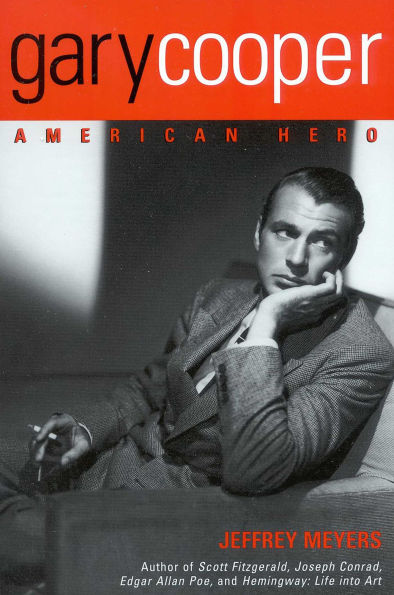Read an Excerpt
Montana, 1901-1909 Gary Cooper, the quintessentially American film hero, was a distinctive blend of English gentleman and Montana pioneer. Wholly English by origin, he had the tall, fair, blue-eyed look of a country squire. His strict Victorian parents influenced his manners and beliefs, and their strength of character had a powerful impact on their son. The Coopers had been farmers in England for centuries. John Cooper, Gary's grandfather, came from Tingrith, near Dunstable, in Bedfordshire. He owned several farms, raised stock, had a milling firm in town and a dairy business, thirty-five miles southeast, in London. Charles Henry Cooper, Gary's father, was one of nine children. He was born on September 15, 1865 at the White House, the family home for four generations, in Houghton Regis, outside Dunstable.
After finishing secondary school, the eighteen-year-old Charles couldn't count on much of an inheritance and had to emigrate to make his fortune. In 1883 he sailed from Liverpool to Boston in the wake of his brother Arthur, a locomotive driver in America. After working for two years in Wisconsin, the adventurous Charles arrived in Helena, in the Montana Territory. When Charles reached Montana, Gary later wrote — in a sentence that suggested his own lifelong interest in animals, Indians and solitude — "buffalo were still running, Indians roamed the plains, [and] the distances between ranches averaged a hundred miles."
As recently as 1876 General George Custer had been killed by the Sioux Indians in the massacre at the Little Bighorn. Arthur and Charles both got jobs with the Northern Pacific Railroad, which ran through Indianterritory and linked the upper midwest to the Pacific coast. It reached Helena in 1883, and the last stagecoach left town that year. Started by James J. Hill, the Northern Pacific was eventually taken over by J. P. Morgan. In nearby Butte the Rockefellers took control of Anaconda Copper. By 1885, said Gary, who was knowledgeable about western history, "cattle were crowding the last of the buffalo off the prairie. The United States Cavalry was keeping the Indians from going on the warpath. Large-scale silver mining was replacing the every-man-for-himself gold boom, and range wars [between cattlemen and homesteaders] were killing nearly as many men as saloon brawls."
In Montana, a major mining state, lucrative deposits of gold, then silver and finally copper had been discovered. Charles and Arthur may have been drawn to the rich territory by reading about the skilled Cornish miners, who played an important role in the silver boom, and the British corporations that invested in Montana mines. In 1899 Montana produced 61 percent of American and 25 percent of world copper; ten years later the mines turned out $46 million of raw wealth, unevenly distributed among the inhabitants of the mining towns. The small towns were surrounded by high forests and mountains, separated by great distances and vast emptiness. The state population climbed from 38,000 in 1880 to 132,000 a decade later to 243,000 at the turn of the century (1.7 persons per square mile), but was still only 376,000 in 1910. Yet Montana was surprisingly cosmopolitan. In 1910 a quarter of the population was foreign-born and spoke more than twenty languages.
In 1885 Charles settled in Helena, which became the state capital in 1894. Important surface deposits had been discovered in Last Chance Gulch in 1864, and Helena, "well-situated on major transportation routes, well-supplied with foodstuffs from the nearby Prickly Pear Valley, and located close to other mining towns," grew from a rough camp into a prosperous trading center. Though the surface gold was soon exhausted, it was replaced by silver, lead, zinc and quartz lodes, and by ranching and farming. Stone buildings, including a bank and United States Land Office, were built in 1867. By 1870, despite its remote location on the mining frontier, Main Street "was lined with impressive commercial buildings, illuminated by electric lights, and traversed by electric streetcars. "Helena, as if to remind its respectable citizens of its rough past, had a lively red-light district (women also worked as rooming house managers, laundresses and servants) as well as a Hanging Tree. As late as 1895 the town issued printed invitations — with photos of those about to be killed — to witness the public execution. This was the gritty world that was later glamorized in so many Western movies.
The copper dome on top of the capitol in Helena symbolized the decade when copper was king. During the 1890s' boom Helena had fifty millionaires — more per capita than any other city in America. This sudden access of wealth led to an orgy of ostentation among the town's parvenus:
They lived in pretentious mansions... and rode about town, first in coaches driven by top-hatted and swallow-tailed coachmen, and later in electric coupes that moved at a dog-trot on the level and stalled on the hills. A small army of maids, butlers, and other servants waited on them, and served them foods and wines as different as possible from the sour-dough, beans, and raw firewater of their prospecting days. The houses they built were ornate affairs in a variety of designs, with exteriors featuring turrets, cupolas, and porte-cocheres; interiors decorated with hand-carved mahogany, oak, and maple, with a fireplace in nearly every room; spacious grounds within stone walls or iron fences, with iron deer on the lawns and stone lions or other figures at the entrances. Some lawns were further adorned with fountains, lead statuary, granite mounting blocks, and carved stone hitching posts.
When the price of silver fell in 1893, this florid period suddenly came to an end.



